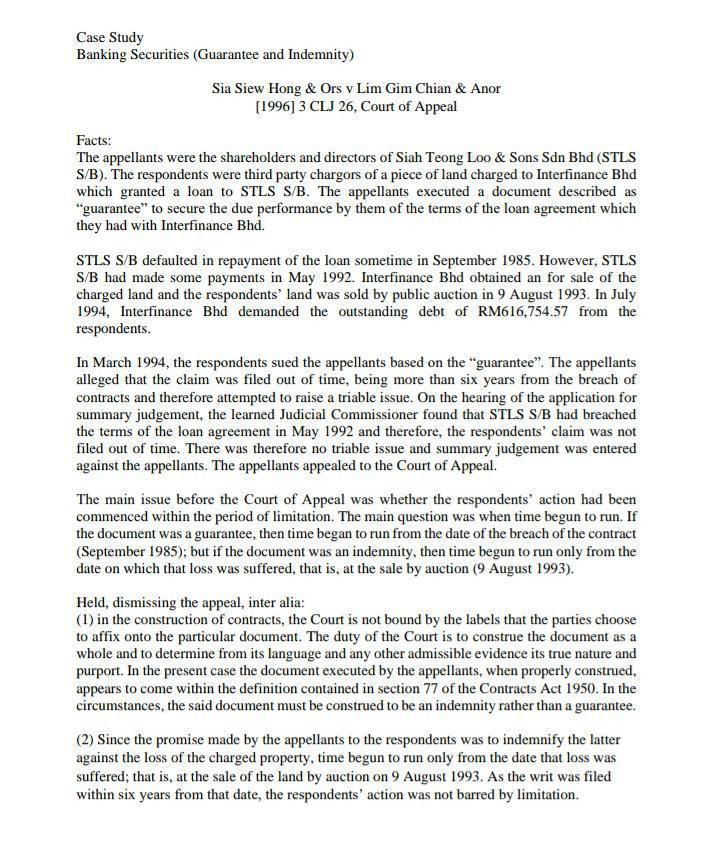Answered step by step
Verified Expert Solution
Question
1 Approved Answer
At the Court of appeal, the main issue is the respondents' action is out of time limit. How does the Court differentiate the time


At the Court of appeal, the main issue is the respondents' action is "out of time" limit. How does the Court differentiate the time limitation for filing for a guarantee and indemnity? Case Study Banking Securities (Guarantee and Indemnity) Sia Siew Hong & Ors v Lim Gim Chian & Anor [1996] 3 CLJ 26, Court of Appeal Facts: The appellants were the shareholders and directors of Siah Teong Loo & Sons Sdn Bhd (STLS S/B). The respondents were third party chargors of a piece of land charged to Interfinance Bhd which granted a loan to STLS S/B. The appellants executed a document described as "guarantee" to secure the due performance by them of the terms of the loan agreement which they had with Interfinance Bhd. STLS S/B defaulted in repayment of the loan sometime in September 1985. However, STLS S/B had made some payments in May 1992. Interfinance Bhd obtained an for sale of the charged land and the respondents' land was sold by public auction in 9 August 1993. In July 1994, Interfinance Bhd demanded the outstanding debt of RM616,754.57 from the respondents. In March 1994, the respondents sued the appellants based on the "guarantee". The appellants alleged that the claim was filed out of time, being more than six years from the breach of contracts and therefore attempted to raise a triable issue. On the hearing of the application for summary judgement, the learned Judicial Commissioner found that STLS S/B had breached the terms of the loan agreement in May 1992 and therefore, the respondents' claim was not filed out of time. There was therefore no triable issue and summary judgement was entered against the appellants. The appellants appealed to the Court of Appeal. The main issue before the Court of Appeal was whether the respondents' action had been commenced within the period of limitation. The main question was when time begun to run. If the document was a guarantee, then time began to run from the date of the breach of the contract (September 1985); but if the document was an indemnity, then time begun to run only from the date on which that loss was suffered, that is, at the sale by auction (9 August 1993). Held, dismissing the appeal, inter alia: (1) in the construction of contracts, the Court is not bound by the labels that the parties choose to affix onto the particular document. The duty of the Court is to construe the document as a whole and to determine from its language and any other admissible evidence its true nature and purport. In the present case the document executed by the appellants, when properly construed, appears to come within the definition contained in section 77 of the Contracts Act 1950. In the circumstances, the said document must be construed to be an indemnity rather than a guarantee. (2) Since the promise made by the appellants to the respondents was to indemnify the latter against the loss of the charged property, time begun to run only from the date that loss was suffered; that is, at the sale of the land by auction on 9 August 1993. As the writ was filed within six years from that date, the respondents' action was not barred by limitation.
Step by Step Solution
★★★★★
3.47 Rating (163 Votes )
There are 3 Steps involved in it
Step: 1
The Court of Appeal has ruled that the limitation period for filing an action for a guar...
Get Instant Access to Expert-Tailored Solutions
See step-by-step solutions with expert insights and AI powered tools for academic success
Step: 2

Step: 3

Ace Your Homework with AI
Get the answers you need in no time with our AI-driven, step-by-step assistance
Get Started


